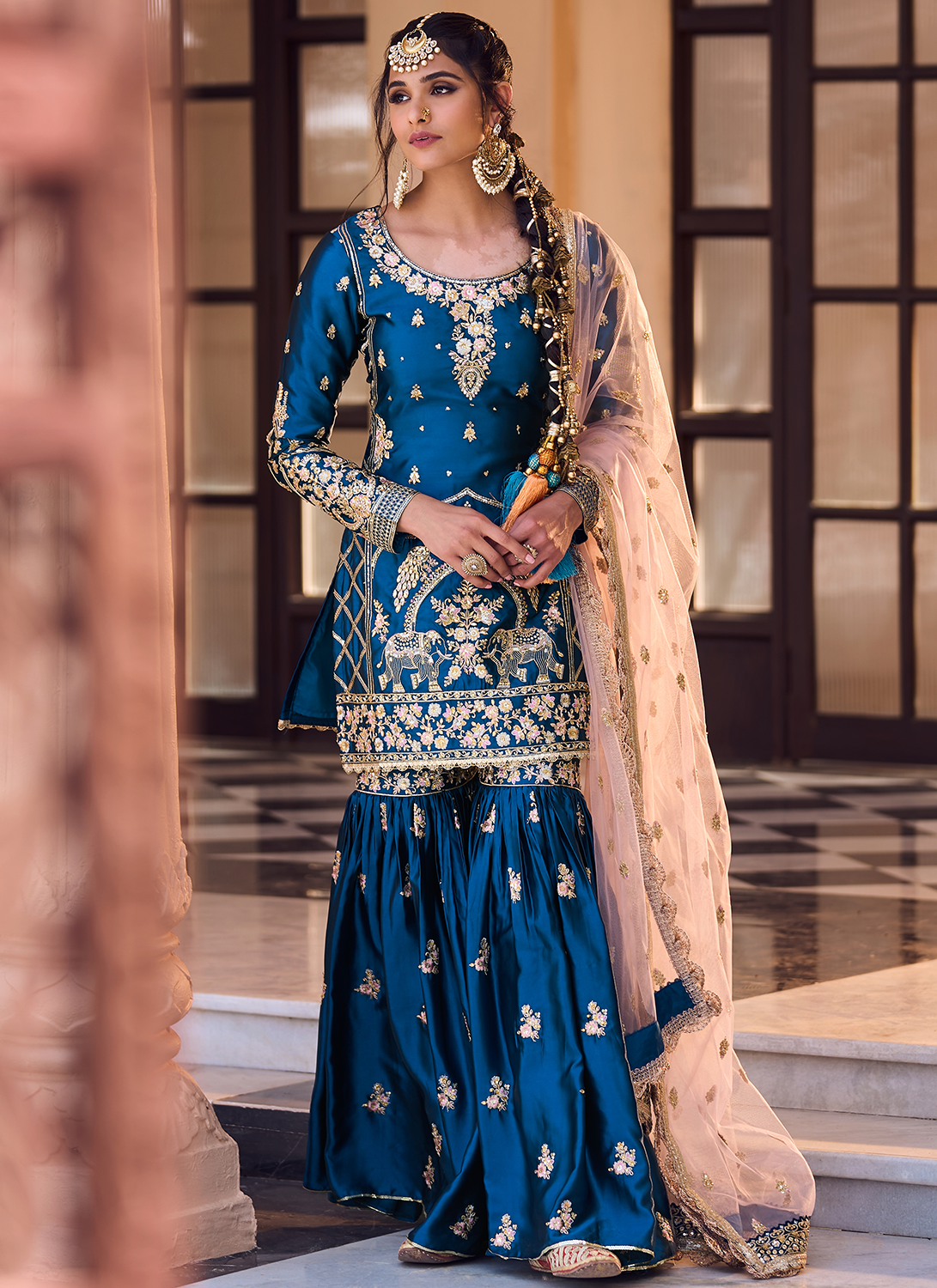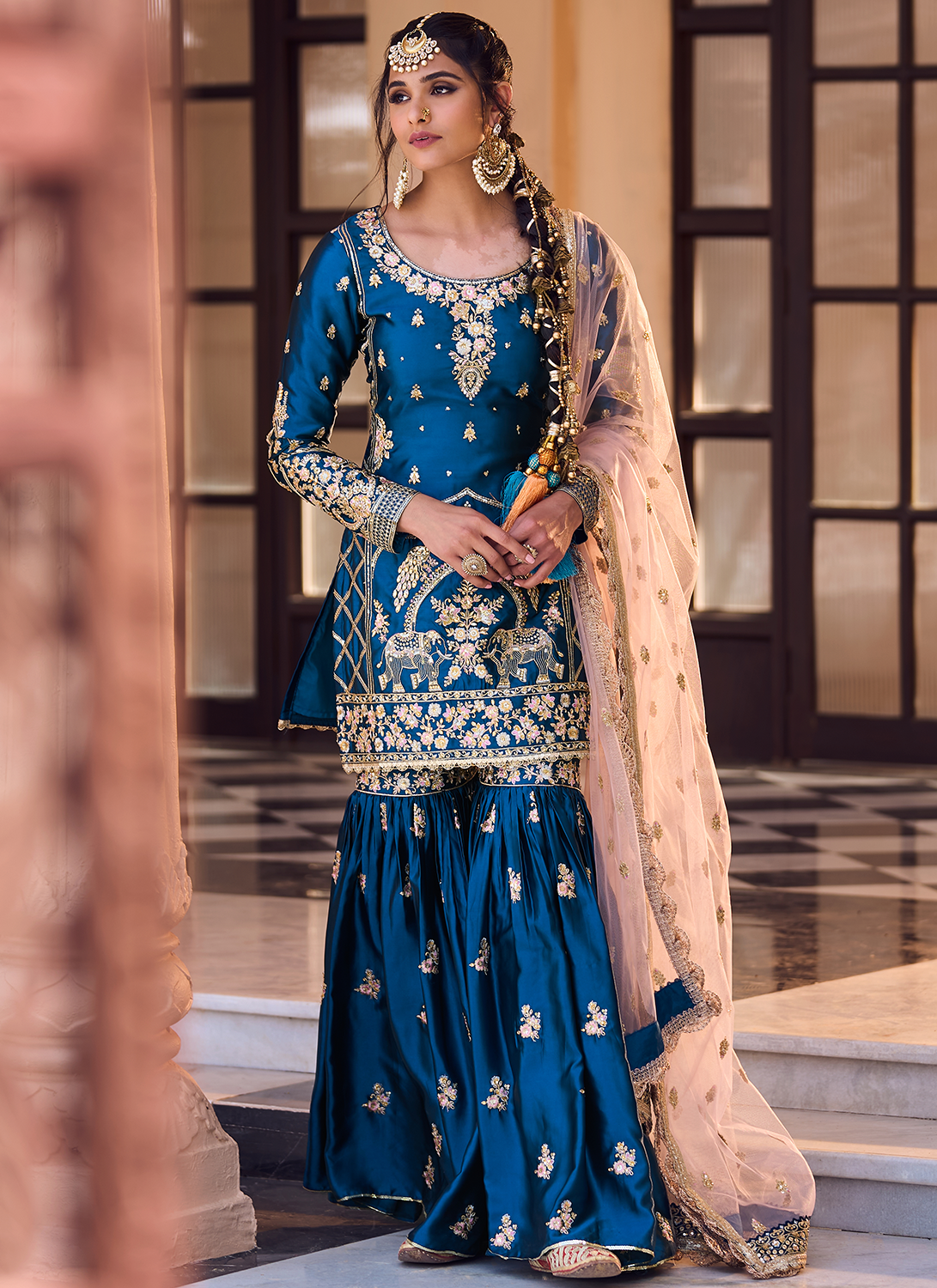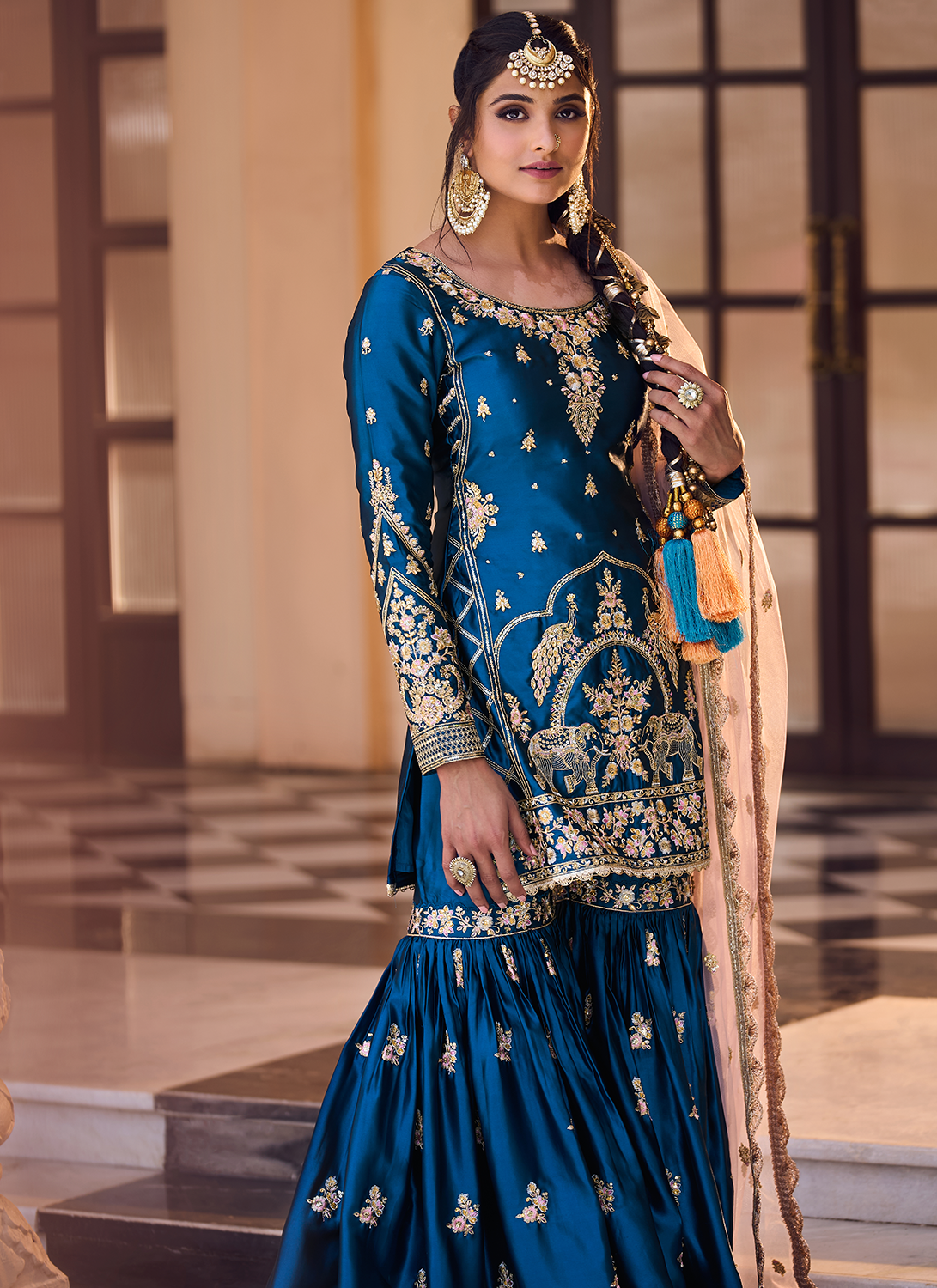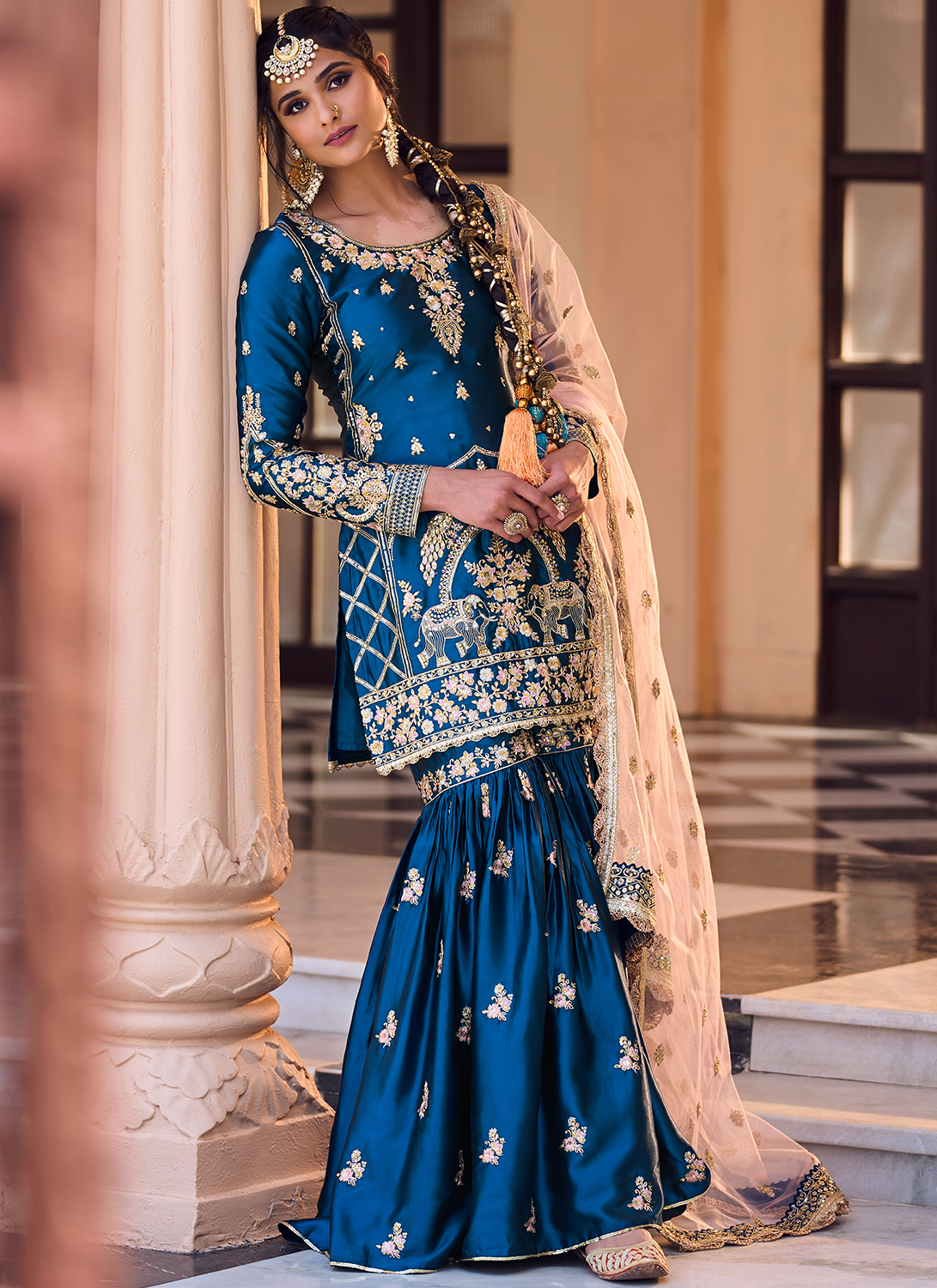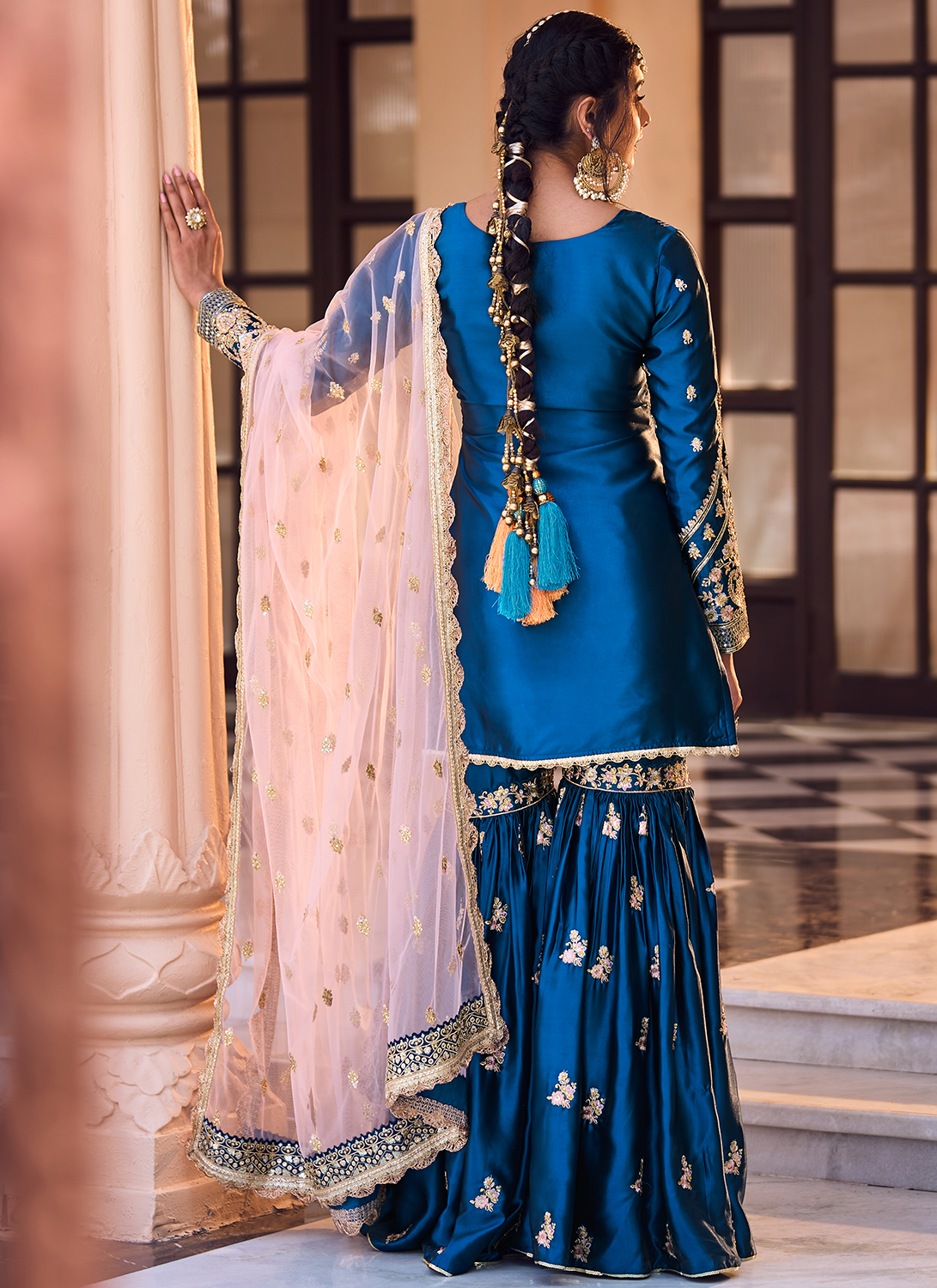What warrants a wardrobe staple? A timeless, wear-anywhere anchor piece that seems fitting is definitely gharara and sharara suits. These traditional ensembles have made a swift comeback in recent times. Once considered as the supporting star of the lehengas and saris act, this style rose to the spotlight in 2019.
Frequently seen in Bollywood fashion worn by celebrities and influencers, both are popularly chosen when it comes to picking out ethnic wear for festivities. The sharara was hugely popularized by the famous Bollywood Actor Kareena Kapoor Khan in the song Bole Chudiyan. However, the silhouette has been around for ages. Actors such as Meena Kumari and Sadhana also wore this style back in the 1960s.
New-age actors like Sara Ali Khan have not only worn the gharara suit in her movie Kedarnath; the actor’s wardrobe holds a lot of Indian ethnic wear which features a number of sharara and gharara styles. Other Bollywood fashion divas like Ananya Panday, Rani Mukherjee, Shilpa Shetty Kundra, Deepika Padukone, among many others have embraced the silhouette.
The drama associated with full and flared sharara and gharara is widely loved. So what’s the difference between the two?
What are the Differences Between Sharara and Gharara Styles?
While sharara and gharara suits are often confused due to their similar silhouettes, the primary difference lies in their structure and styling. Both styles have historical roots in Mughal fashion and continue to be a staple in South Asian ethnic wear, particularly for weddings and festive occasions. However, their key distinctions set them apart in terms of fit, flare, and overall aesthetic.
What is a Sharara?
A sharara is a type of outfit with wide-legged, flowy pants that look like a long skirt when worn. These pants fit snugly around the waist and hips but flare out from the thighs or knees, giving them a free and comfortable feel.
Since there’s no seam at the knee, shararas have a smooth, flowing look. They’re great for weddings, festive events, or even as bridesmaid outfits because they’re both stylish and easy to move in. Sharara sets often come with longer kurtas or trendy peplum tops, making them perfect for a mix of traditional and modern styles.
What is a Gharara Suit?
A gharara, on the other hand, has a unique design with a seam at the knee, where the fabric is gathered or pleated. This creates a structured, voluminous flare below the knee, giving it a more dramatic and traditional look.
Ghararas are usually paired with short kurtis and richly decorated dupattas. The pleats below the knee add extra volume, making them appear fuller than shararas. They are often made from luxurious fabrics like brocade, silk, or velvet and are decorated with detailed embroidery, zari, or gota patti work. Ghararas are typically worn for grand celebrations, as they have a more royal and vintage feel.
One of the biggest differences between the two is how they move and feel when worn. Since shararas have a smooth flare, they are easier to walk and dance in, making them a comfortable option for long events.
Ghararas, with their structured pleats and fitted knee area, have a more regal look but can feel a bit stiffer. This makes them a better choice for formal occasions where a more traditional outfit is preferred.
With the difference between these two pieces explored, let’s look at some specific outfits. This will help highlight what makes each unique and showcase why they have the staying power they do.
Sharara and Gharara Suit Style Examples
Both sharara and gharara have their roots in the Mughal era. Often reserved for weddings or special occasions, they also form a part of bridal trousseau. This suit style is popular for events like a sangeet function and are even worn by Punjabi and Muslim brides today.
The Exquisite Beauty of the Sharara
Comfortable yet a thing of beauty, the sharara suit remains one of the easiest ways to dress up for a special occasion. With the wedding and festive season around the corner, what else could equip you for a puja, poolside mehendi, sangeet night or rakhi? Sharara sets can be translated in every situation. Fans of the silhouette include Alia Bhatt, Kiara Advani, Kriti Sanon among many other Bollywood A-listers.
Style One

Lashkaraa’s range of sharara suits offers a diverse selection of scene-stealing pieces, and the Dusty Green Embroidered Sharara Suit is no exception. This elegant ensemble beautifully merges traditional craftsmanship with modern aesthetics, making it a perfect pick for festive gatherings, weddings, or grand celebrations. The muted dusty green hue offers a refreshing alternative to conventional bright colors, giving it a sophisticated and regal appeal.
Style Two

For those who love a classic and opulent aesthetic, the Off White and Gold Sharara Suit is a stunning choice. This timeless combination of off-white and gold embodies regal elegance, making it perfect for wedding ceremonies, festive occasions, and grand receptions.
Style Three

For a trendy and youthful take on the classic sharara, the Light Pink Embellished Crop Sharara Suit offers the perfect fusion of contemporary style and ethnic charm. The soft pastel pink shade brings a refreshing and feminine touch, making it a beautiful option for pre-wedding festivities like mehendi, haldi, or sangeet functions.
The Timeless Charm of the Gharara
The gharara suit is a happy half-way point between a lehenga and a been-there-done-that salwar kameez. This one can equally take you from a puja ceremony at home straight to a wedding as a guest or even the bride. Its edgy traditionalism and contemporary feel makes it a favorite in every woman’s closet.
Style One

Traditional gharara suits that have a regal aesthetic to them, like our Teal and Peach Embroidered Gharara Suit from the collection ‘Hoor, are timeless statements that can be styled in a versatile way.
Style Two

The Maroon Embroidered Crepe Gharara Suit from the brand is a rich and elegant ensemble, perfect for festive and wedding celebrations. With intricate embroidery adorning the kurta and a structured gharara flare, this outfit exudes traditional charm while ensuring comfort and style.
Style Three

The Purple Embroidered Peplum Style Gharara is the perfect mix of traditional charm and modern flair. With its trendy peplum top covered in intricate embroidery and flowy gharara pants, this outfit is a total head-turner for any festive celebration.
Style Your Gharara and Sharara The Right Way
Styling can make or break any outfit. When it comes to Indian ethnic wear, it is especially true. Ghararas exude a rather grand and dignified vibe and are best styled traditionally.
One can play around with the jewelry by incorporating a maang-tikka or passa on the forehead. This striking jewelry style will not be one to miss. Ghararas often pair well with large and bold jhumkas or chaandbalis. Add a couple of bangles to the mix and you’re ready for any special occasion!
You can even go for statement kadas. For a traditional look, one can go for a hair bun or a one-sided braid to go with this style. Add some hair accessories, hair bun pins or gota string. This would make for a stunning traditional look.
The dupatta can be draped in multiple ways, starting from either on one side of the shoulder or spread across the neck. Another way would be to take it on the back and bring it forward on the shoulders to elegantly wrap the drape around the arms.
To give it an absolutely royal touch, opt for juttis. This would allow the sharara and gharara styles to sweep through the floor and will showcase the work on the pants better.
Styling a Sharara For Millennials
The sharara’s evolution into a two-piece hands-free ethnic wear has made it a millennial favorite. This fuss-free traditional ensemble can be styled in unusual ways. A heavily embellished contemporary style sharara set like our Periwinkle Embellished Crop Sharara Set comes in a youthful hue and is hands-free. Style this one with a sleek ponytail at the back, experiment with some lilac or blue eye shadow and go for statement jewelry.
An in-trend strappy top sharara demands a playful style aesthetic. Our Light Green Sharara Suit, with embellishments on chinon fabric, can be styled with statement jewelry and soft open waves for the hairdo. One can further elevate the outfit by adding some flower petals or butterfly accessories on the hair, mirroring the embellishments on the outfit.
Sharara & Gharara Styles That Steal the Spotlight
Shararas and ghararas have been around for ages, and they’re still a go-to for weddings, festive celebrations, and special occasions. Whether you’re all about the effortless, flowy vibe of a sharara or the structured, vintage charm of a gharara, these outfits bring the perfect mix of tradition and style.
Styling these outfits is all about balancing tradition with your personal style. Pair them with statement jewelry, chic hairstyles, and the right accessories to elevate your festive look. Whether you prefer a timeless, heavily embroidered suit or a trendy, minimalistic design, these outfits offer endless possibilities for creating unforgettable fashion moments.
There are a myriad ways to style different types of shararas and ghararas. Pick your favorite outfit with Lashkaraa in our Gharara Suit and Sharara Suit collections.
References:
India. The Mughal Empire. Costume and fashion history. | World4









